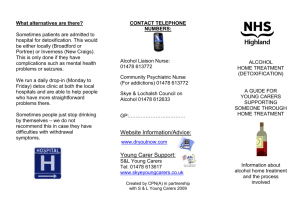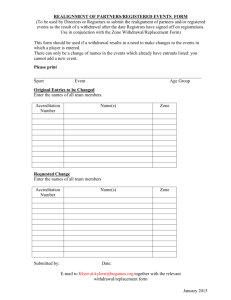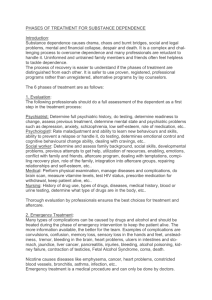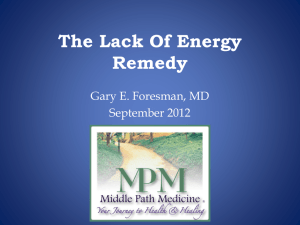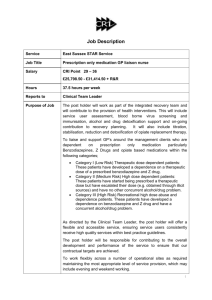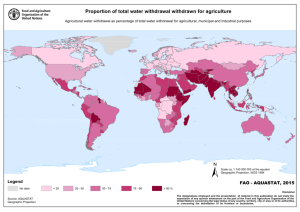Presentation - LSU Hospitals
advertisement
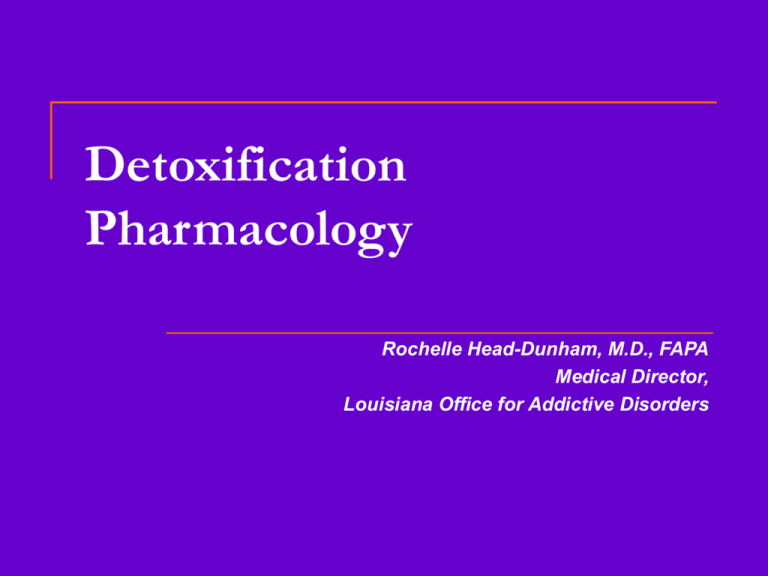
Detoxification Pharmacology Rochelle Head-Dunham, M.D., FAPA Medical Director, Louisiana Office for Addictive Disorders Goals & Objectives Discuss general guidelines and considerations for withdrawal and detoxification Discuss detoxification protocols for three major classes of substances of dependence Withdrawal Syndrome The characteristic group of signs and symptoms that typically develop after a rapid, marked decrease or discontinuation of a substance of dependence, which may or may not be clinically significantly of life threatening. Withdrawal Syndrome Withdrawal severity and duration depend on several factors: 1. 2. 3. 4. 5. 6. 7. Nature of substance Half-life and duration of action Length of time substance used Amount used Use of other substances Presence of other medical and psychiatric conditions Individual biopsychosocial variables The Clinical Assessment The diagnosis of dependence is made through a careful patient history and physical examination, focusing on the following information: Drug type, route and duration of use, symptoms with cessation and last use Risk factors, symptoms and previous testing for blood-bourn pathogens Past Medical History and review of symptoms of chronic use such as malnutrition, tuberculosis infection, trauma, endocarditis, and sexually transmitted diseases Physical Examination to include vital signs, and cardiac status for evidence of fever, heart murmur, or hemodynamic instability; exam should focus on skin areas for scarring, atrophy, infection Laboratory Evaluation should include a complete blood count, comprehensive chemistry panel, HIV testing, EKG, Chest x-ray, screening for STD’s Urine Drug Screens and Breath Analysis (Alcohol) Detoxification The physiological process of withdrawal from a substance of dependence which requires medication management, careful monitoring, and the availability of lifesaving emergency interventions. Detoxification Levels of Care Severity of Withdrawal dictates appropriate level of care: Medical Detoxification (24-hour care, hospital setting)* Medically Supported Detoxification (24 hour care, non-hospital/residential setting with profession medical staff) Social Detoxification (24 hour care, nonhospital/residential setting without professional medical staff) *May occur in outpatient setting with skilled clinician. Detoxification General Consideration 1. 2. 3. 4. 5. High index of suspicion, non-judgmental questions, careful screening and assessment Anticipate inaccurate/minimized reports of use Psychological withdrawal for all, physiological for some All withdrawal syndromes not clinically significant Dangerous syndromes: Alcohol, Sedative/hypnotic and Anxiolytic Withdrawal; Opiate withdrawal is extremely uncomfortable Detoxification General Consideration (con’d) 6. 7. 8. 9. 10. Rule of thumb: Substitute long acting, cross-tolerant substance with gradual tapering by 10-20% per day Use adequate dosages for comfort Limit access to controlled substances Detox alone is rarely adequate treatment Management of co-morbid medical and psychiatric conditions Role of Medication in Detoxification Stabilization of psychological or physiological withdrawal symptoms Medical emergencies: Alcohol, Sedativehypnotics, Benzodiazepines, Remediation of non-life threatening, relapsetriggering symptoms Stabilization of co-morbid conditions ALCOHOL Detoxification Alcohol Withdrawal 1. 2. 3. Autonomic dysfunction-Insomnia-Anxiety Onset 8+ hrs, Peak 48hrs, Diminished 5dys, Duration 3-6 months Withdrawal Syndromes: Mild, moderate or life-threatening severity (increased severity with BAL>100mg/dl) 3% Withdrawal Seizures (w/in 48hrs of abstinence) Delirium Tremens (DTs) – Medical Emergency! (w/in 48-72hrs of abstinence) (4-5% Prev., M&M<5% w/o tx, <1% w/tx) Withdrawal Assessment Clinical Institute Withdrawal Assessment-Alcohol, revised (CIWA-Ar) Nausea Tremor Diaphoresis Anxiety Auditory disturbances Orientation Agitation Tactile disturbances Visual disturbances Headaches Withdrawal Severity: 0 (not present) to 67 (extreme); Higher = >risk 8-10 Mild –Supportive, no Meds (i.e. Social Detox) 10-15 Moderate - Some meds (BZP) (i.e. Medically Supported Detox) 15/> Severe - DT Risk (i.e.. Hospitalization) N.B. May also be used to monitor recovery and medication management Sample Medication Protocol Days 1-2 : Lorezepan 1-2 mg three times a day Days 3-4: Lorezepam 1-2 mg twice daily Day 5: Lorezepam 1-2mg, daily *Adjust dosage and duration for intoxication or prolonged withdrawal Adjunctive treatments: 1. Seizure history: Tegretol 200mg/Neurontin 400mg (5dy taper) Sympathetic activity: Clonidine 0.1-0.2q8hrs (3-5dys) Fluids, MVI, Thiamine Manage co-morbid conditions 2. 3. 4. BENZODIAZEPINES General Consideration Sedative-hypnotic (Benzodiazepine) Detoxification Symptoms similar to alcohol but no objective measure/scoring system High risk of delirium, seizures and death requires treatment Sub-clinical symptoms may persist for months Tolerance develops within 3-4 weeks of regular use Onset of withdrawal symptoms determined by half-life of compound Benzodiazepine Detoxification guidelines: Slow-tapering of the compound or use of a longer acting benzodiazepine recommended (i.e., Clonazepam TID with 10% tapering daily) Sedatives for insomnia (i.e. antidepressants) Avoid beta blockers (mask symptoms) Anti-seizure medications adjusted and monitored OPIATES Opiate Indications for Use 1. Addiction Maintenance Therapy Methadone (Pure Mu Opioid Agonist) Naltrexone (Opioid Antagonist) Buprenorphine (Opioid Agonist- Antagonist) (N.B. LAMM now Minimally Available) 2. Pain Management Opiate Detoxification Key Considerations: Medical Detoxification = Standard of Care Methadone short-term substitution therapy = the preferred method of detoxification, but… Goal of treatment = reducing withdrawal discomforts, with or without Methadone or Narcotic Substitution Opiate Detoxification Key Considerations (con’d): Comprehensive, long-term treatment is equally important as alleviating acute symptoms Fear and Anticipatory Anxiety = predominate emotional responses to detoxification Counseling prior to detoxification is necessary (i.e. expectations of withdrawal, treatment planning, patient responsibilities…) Treatment should be: individualized, reviewed and approved by a physician Opiate Detoxification and Pregnant Women CONTRAINDICATED! Methadone maintenance is the recognized standard of care for decreased risk of miscarriage and premature labor. Opiate Withdrawal Syndrome 1. Not life threatening, Extremely uncomfortable 2. Symptom onset and duration, half-life dependent 3. Common Sns & Sxs: Yawning Sweating Tearing Abdominal Cramps Nausea and/vomiting Diarrhea Weakness Dilated Pupils Goose bumps Muscle twitching aches and pain Anxiety Insomnia Increased pulse Increased Resp rate Elevated Blood pressure Opiate Detoxification Pharmacological Guidelines (cont.) Naltrexone Only opioid antagonist approved in the United States Used for rapid detoxification due to accelerated binding and blocking of mu receptors, precipitating a profound withdrawal Limitation: must be administered in hospital or supervised environment when prescribed for rapid detoxification Opiate Detoxification Advantages of Methadone Daily dosing due to 24 hour half-life, requiring slower tapering schedule Long half-life safe for all opiates Safe in pregnancy May be used in combination with other medications for co-occurring disorders or mild withdrawal symptoms Decreases morbidity and mortality, hepatic damage, and HIV Exception: licensing requirements, very addictive Opiate Detoxification Methadone Guidelines: Stabilize Withdrawal: 5-10 mg prn every 4-6 hours to control objective signs of withdrawal Monitor respiratory depression and excessive sedation until stabilized Detoxification: Reduce by 10%/day after stabilized for 2-3 days Clonidine 0.1-0.2mg/day for duration Opiate Detoxification Levels of Care Inpatient Setting Outpatient Setting 1. Duration: 4-7 days Usual dose to suppress symptoms: 30-40mg/day Methadone Immediate Referral to drugfree treatment setting Clonidine (Catapres) can be considered an effective alternative treatment for inpatient opioid detoxification but not outpatient 1. 21 day protocol sufficient for most stable, motivated patients 180 day protocol, done within an opioid agonist therapy program, should be considered to work on patients’ early recovery problems, while stabilized on relatively low dose (5060mg) Methadone 2. 3. 4. 2. Opiate Detoxification Buprenorphine History: October 2000amended Control Substance Act: 30 patient/MD max for opioid dependence treatment, with DEA waiver; Goal: accessibility, expanded treatment capacity Partial mu agonist antagonist: ceiling effect (safer), sublingual absorption, Suboxone preferred Dosing instructions dependent on half-life of substituted opiate Average tolerable maintenance dose is 4-32 mg SL/day to every 3rd day Detox at 10%/day as tolerated Opiate Detoxification Pharmacological Guidelines (cont.) Adjunctive Treatments Nonsteroidal Anti-inflammatory Agents for pain and fever (i.e. Tylenol, Aleve) Alpha-adrenergic blocker for sympathetic hyperactivity such blood pressure, nausea, vomiting, diarrhea, cramps and sweating (i.e. Clonidine/Catapres) Antidiarreals and anti-emetics to control gastrointestinal symptoms (i.e. Bentyl, Phenergan) Antidepressants/Antipsychotic for dysphoria, anxiety and insomnia (i.e. Trazedone/Elavil/Seroquel with/without Lexapro) Psychotropics for co-morbid psychiatric conditions along with medications for medical conditions Concluding Comments 1. 2. 3. 4. 6. All withdrawal syndromes are not clinically significant Dangerous syndromes: Alcohol, Sedative/hypnotic and Anxiolytic withdrawal; Opiates withdrawal, extremely uncomfortable Substitute long acting, cross-tolerant substance with gradual tapering by 10-20% per day Detox alone is rarely adequate treatment Management of co-morbid medical and psychiatric conditions
